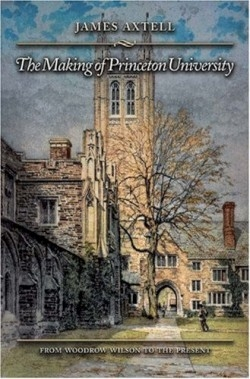The Making of Princeton University
From Woodrow Wilson to the Present
“Trying to get an education at Princeton is like trying to get a drink of water from a fire hydrant,” observed a student in 1994. Such high praise for the intellectual environment at one of the country’s most prestigious universities is surely deserved. Just how the school became that way is the subject of James Axtell’s illuminating depiction of Princeton’s growth from a small, liberal arts college at the turn of the twentieth century to its status as a reigning intellectual power today.
The attempt to chronicle the evolution of a university is an ambitious one. It’s an endeavor, in fact, that Princeton itself refused to take on in its 250th anniversary year, citing the troubles caused by a fifty-year hold on many crucial records. Instead of a comprehensive history, Princeton produced a coffee-table book celebrating its first 250 years.
It was an outsider who finally stepped up to the plate. Author Axtell admits from the start his status as “a true-blue graduate of Yale.” A student from 1959-63 and a professor from 1966-72, Axtell rails against the belief that only an insider was fit for the job, arguing that only a foreigner could shed the light of objectivity on the subject. And, with that in mind, he plunges into Princetoniana.
In its early stages, Princeton was the runt of the litter. Even when grouped in “The Big Three,” Princeton stood in the shadows of collegiate giants Harvard and Yale. Without a sufficient library, a professional school, or a healthy endowment, Princeton longed to be a university but still remained very much “a college in spirit.”
The story of Princeton’s growth could have easily been a dry, historical tale, but Axtell provides readers a soap-operatic glimpse behind ivy-covered walls. Anecdotes enliven the “how” and “what” of the university’s development to provide the book’s life:
The inception of the preceptorial system (in which academic emphasis was moved from large lecture halls to smaller group settings) was surely revolutionary, but Axtell cites an interesting byproduct of the new method: the dramatic increase in the student body’s reliance on prescriptive eyeglasses. Axtell mentions both mental and manual labor in his chapter on the library’s 1948 creation, noting that it took a team of thirty-seven undergraduates ten weeks to cart the library’s one-million-plus books the 100 yards from their cramped quarters in Chancellor Green to their new home in Firestone library. Axtell’s examination of intellectual life is interesting, but particularly so is the news that students in the mid-1940s got in-the-field experience excavating fossils when a school of 175-million-year-old fish was discovered under a campus building.
Axtell’s retelling is vivid, particularly as he tracks larger societal changes alongside the university’s transformation. His explanation of Princeton’s changing politics, style and patois serves as a fascinating guidebook to understanding the university through all its various permutations.
The figure of Woodrow Wilson, Princeton’s thirteenth president who later took up residence in the White House, looms large. Axtell first encountered Wilson while writing a high school paper and, revisiting him thirty years later, was still riveted. Thus, Axtell centered his educational history of Princeton around one of its most influential and formative leaders. Wilson’s ideology serves nicely as the jumping-off point for chapters covering admissions, the fight for the graduate school, extracurricular activities, and the eventual creation of the library, the art museum and the university press.
But it’s not just famous figures from the past who star in Princeton’s story. Axtell circumvented the fifty-year hold on institutional records by relying on letters as well as articles from the Princeton Alumni Weekly (the alumni magazine produced twenty-one times a year) and The Daily Princetonian (the campus daily). In doing so, Axtell creates a story centered on the voices of students and alumni.
Not all of Princeton’s history is rosy. The school has perennially struggled to shake its “country club” reputation as a playground for the rich. It hasn’t helped matters that the university received much attention for its infamous eating clubs (with which “Princetonians turned eating into a contact sport”) and the Nude Olympics (a naked sporting event set for each year’s first snow fall that was banned in 1999 after property damage and allegations of sexual assault).
But despite some flaws, the university has magic that accounts for the undying loyalty of its alumni. Axtell himself was seduced, admitting that even he, a staunch bulldog, developed “faint but unmistakable orange and black stripes.” And in writing his history of Princeton, he’s done the university a great service, as the depth of Princeton’s coffers is often alluded to, but Axtell shows here that its history is just as rich.
Disclosure: This article is not an endorsement, but a review. The publisher of this book provided free copies of the book to have their book reviewed by a professional reviewer. No fee was paid by the publisher for this review. Foreword Reviews only recommends books that we love. Foreword Magazine, Inc. is disclosing this in accordance with the Federal Trade Commission’s 16 CFR, Part 255.

